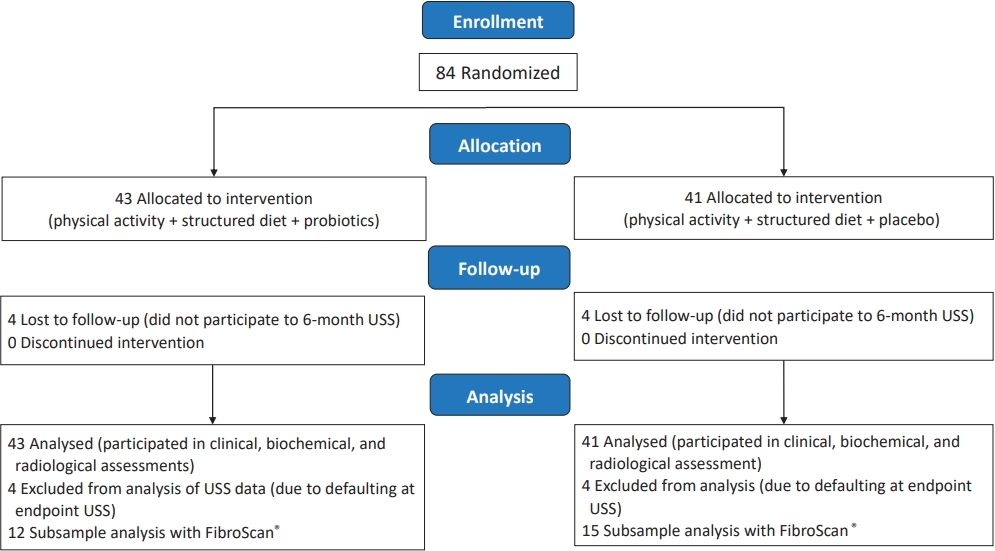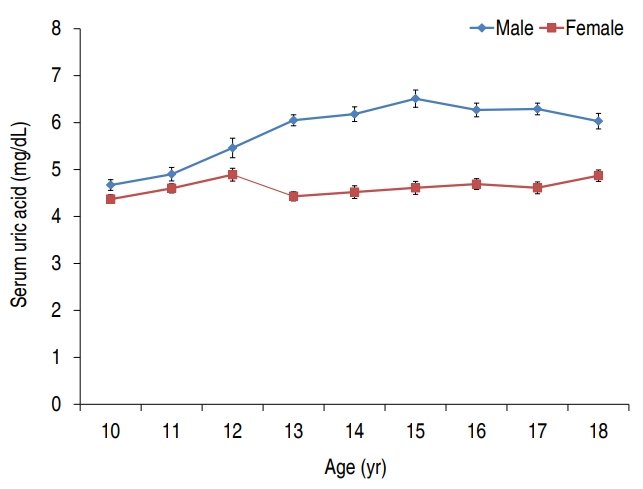Search
- Page Path
-
- HOME
- Search
- Review Article
- Metabolic complications of obesity in children and adolescents
- Hyunjin Park, Jung Eun Choi, Seunghee Jun, Hyelim Lee, Hae Soon Kim, Hye Ah Lee, Hyesook Park
-
The global prevalence of childhood and adolescent obesity, exacerbated by the COVID-19 pandemic, is affecting not only school-aged children but also preschoolers. Early-onset obesity, along with a higher risk of metabolic complications, may contribute to a lower age of onset of cardiovascular disease (CVD). As metabolic diseases such as diabetes, dyslipidemia, and non-alcoholic fatty liver disease (NAFLD) observed in adulthood... -
DOI: https://doi.org/10.3345/cep.2023.00892 [Accepted]
- Original Article
- Endocrinology
- Effects of probiotics combined with dietary and lifestyle modification on clinical, biochemical, and radiological parameters in obese children with nonalcoholic fatty liver disease/nonalcoholic steatohepatitis: a randomized clinical trial
- Thushara Rodrigo, Samaranayake Dulani, Sumudu Nimali Seneviratne, Arjuna P. De Silva, Jerad Fernando, H. Janaka De Silva, Jayasekera , V. Pujitha Wickramasinghe
- Clin Exp Pediatr. 2022;65(6):304-311. Published online November 11, 2021
-

Question: Could probiotics be used as a therapeutic modality in nonalcoholic fatty liver disease/nonalcoholic steatohepatitis?
Finding: There seem no added advantages over lifestyle modifications compared to Probiotics.
Meaning: There does not seem to be an advantage of probiotics over lifestyle modifications in improving obesity-associated metabolic derangement in children.
- General Pediatrics
- Prevalence of hyperuricemia and its association with metabolic syndrome and cardiometabolic risk factors in Korean children and adolescents: analysis based on the 2016–2017 Korea National Health and Nutrition Examination Survey
- Jung Hyun Lee
- Clin Exp Pediatr. 2019;62(8):317-323. Published online June 24, 2019
-

Purpose: Investigating the prevalence of hyperuricemia and its association with metabolic syndrome (MetS) and cardiometabolic risk factors (CMRFs) in Korean children and adolescents. Methods: This cross-sectional survey used data from the 7th Korea National Health and Nutrition Examination Survey (2016–2017); 1,256 males and females aged 10–18 years were included. Hyperuricemia was defined as serum uric acid levels were >6.6 mg/dL at...
- Cardiology
- Subtle inflammation: a possible mechanism of future cardiovascular risk in obese children
- Watchareewan Sontichai, Prapai Dejkhamron, Peraphan Pothacharoen, Prachya Kongtaweelert, Kevalee Unachak, Nuthapong Ukarapol
- Clin Exp Pediatr. 2017;60(11):359-364. Published online November 27, 2017
-
Purpose The risk of cardiovascular disease (CVD) has been shown to be associated with systemic inflammation in obese adults with metabolic syndrome (MetS). The aims of this study were to evaluate the prevalence of MetS and its relation to inflammatory markers in obese Thai children.
Methods A cross-sectional study was conducted. Children with history of endogenous obesity, chronic diseases, drug ingestion, and any...
- Dietary patterns and metabolic syndrome risk factors among adolescents
- Hyojee Joung, Soyoung Hong, Yoonju Song, Byung Chul Ahn, Mi Jung Park
- Clin Exp Pediatr. 2012;55(4):128-135. Published online April 30, 2012
-
Purpose Unbalanced diets and decreased physical activity have contributed to increased prevalence of obesity and metabolic syndrome in adolescents. We have performed a systematic review and data analysis to examine the association between dietary pattern and metabolic syndrome risk factors in adolescents.
Methods We searched the PubMed and BioMedLib databases for appropriate articles published during the past 10 years and selected 6 articles....
- The metabolic syndrome and body composition in childhood cancer survivors
- Young Bae Sohn, Su Jin Kim, Sung Won Park, Se-Hwa Kim, Sung-Yoon Cho, Soo Hyun Lee, Keon Hee Yoo, Ki Woong Sung, Jae Hoon Chung, Hong Hoe Koo, Dong-Kyu Jin
- Clin Exp Pediatr. 2011;54(6):253-259. Published online June 30, 2011
-
Purpose Long-term survivors of childhood cancer appear to have an increased risk for the metabolic syndrome, subsequent type 2 diabetes and cardiovascular disease in adulthood compared to healthy children. The purpose of this study was to investigate the frequency of the metabolic syndrome and associated factors in childhood cancer survivors at a single center in Korea.
Methods We performed a retrospective review of...
- Prevalence and risk factors of the metabolic syndrome in young adults with childhood-onset hypopituitary growth hormone deficiency
- Han Hyuk Lim, Min Jae Kang, In Suk Yun, Young Ah Lee, Choong Ho Shin, Sei Won Yang
- Clin Exp Pediatr. 2010;53(10):892-897. Published online October 31, 2010
-
Purpose This study evaluated the prevalence of the metabolic syndrome (MetS) and risk factors for metabolic derangement in young adults with childhood-onset hypopituitary growth hormone deficiency (ACOHGHD).
Methods Thirty patients with ACOHGHD who were treated with hormone-replacement therapy, aged 18 to 29 years, who visited the Seoul National University Children's Hospital between September 2009 and February 2010 were enrolled. Height, weight, waist circumference,...
- Metabolic syndrome in the overweight and obese adolescents and the impact of obesity on the cardiovascular system
- Yong Mi Hong, Young Young Song, Hae Soon Kim, Hae Sook Park, Jung Hae Min, Jo Won Jung, Nam Soo Park, Chung Il Noh
- Clin Exp Pediatr. 2009;52(10):1109-1118. Published online October 15, 2009
-
Purpose : Metabolic syndrome (MS), characterized by obesity and insulin resistance, elicits risk factors such as hyperlipidemia, hypertension, and glucose intolerance with additive effects on atherosclerosis, leading to cardiovascular diseases. The purposes of this study were to evaluate the prevalence of MS among overweight and obese adolescents and to investigate the impact of obesity on the cardiovascular system. Methods : In... -
- Review Article
- Metabolic syndrome in children and adolescents
- Young Mi Hong
- Clin Exp Pediatr. 2009;52(7):737-744. Published online July 15, 2009
-
Metabolic syndrome (MS) in children and adolescents has become a global public health problem. MS among Korean children and adolescents has been increasing significantly over the past decade. This paper aims to provide the currently available information on the MS in children and adolescents. This review focuses on the definition, diagnostic criteria, epidemiology and pathophysiology which may be helpful for... -
- Original Article
- Development of metabolic syndrome and its correlation with insulin resistance in adult patients with Turner syndrome
- Joo Hwa Kim, Min Jae Kang, Choong Ho Shin, Sei Won Yang
- Clin Exp Pediatr. 2009;52(3):370-375. Published online March 15, 2009
-
Purpose : The risk of metabolic syndrome (MS) and cardiovascular disease in Turner syndrome (TS) patients is high. We analyzed metabolic factors in adults with TS and evaluated the metabolic risk of insulin resistance. Methods : Forty-three adults with TS were enrolled. The frequency of MS and the values of the metabolic factors were analyzed. Patients were divided into insulin... -
- Review Article
- Consequences of being born small for gestational age : More than being small
- Eun-Gyong Yoo
- Clin Exp Pediatr. 2009;52(2):152-158. Published online February 15, 2009
-
Reduced fetal growth is independently associated with increased risk of health problems in later life, particularly type 2 diabetes and cardiovascular diseases. Insulin resistance appears to be a key component underlying these metabolic complications. It is suggested that detrimental fetal environment may program insulin resistance syndrome. An insulin-resistant genotype may also result in both low birth weight and insulin resistance... -
- Original Article
- Preliminary analysis of metabolic syndrome components in Korean adolescents by using Korean national health and nutrition examination Survey pooling data (1998, 2001, and 2005)
- Kyoung Huh, Mi Jung Park
- Clin Exp Pediatr. 2008;51(12):1300-1309. Published online December 15, 2008
-
Purpose : This study aimed to estimate age- and gender-specific cut points for metabolic syndrome (MS) components, including body mass index (BMI), blood pressure (BP), triglycerides, high-density lipoprotein (HDL) cholesterol, and glucose. Methods : Data from the 1998, 2001, and 2005 Korean NHANES (National Health and Nutrition Examination Survey) were analyzed (n=4164; 2,139 boys and 2,025 girls, aged 10-19 years).... -
- Review Article
- Epidemiologic characteristics of type 1 diabetes in children aged 14 years or under in Korea, 1985-2000
- Choong Ho Shin
- Clin Exp Pediatr. 2008;51(6):569-575. Published online June 15, 2008
-
Type 1 diabetes mellitus (T1DM) develops in genetically susceptible individuals as a result of progressive autoimmune destruction of beta cells. There is a large global variation in incidence among children aged 0-14 years. The incidence of T1DM in Korea is very low. The latest survey in Korea was conducted in 2001 by the Korean Society of Pediatrics to analyze ... -
- Epidemiology of the metabolic syndrome among Korean children and adolescents
- Mi Jung Park
- Clin Exp Pediatr. 2008;51(6):564-568. Published online June 15, 2008
-
The prevalence of obesity in Korean children is estimated to be around 10%, and has increased significantly over the past 20 years. Metabolic syndrome, which includes central obesity, glucose intolerance, insulin resistance, dyslipidemia, and hypertension, is a well documented risk factor for cardiovascular diseases, but there is no general consensus concerning its definition for children. In this study, ablut 30-40%... -
- Type 2 diabetes mellitus and metabolic syndrome
- Jin Soon Hwang
- Clin Exp Pediatr. 2006;49(7):710-717. Published online July 15, 2006
-
Type 2 diabetes mellitus in children and adolescents has been increasing for last 10 years. The increase in frequency of type 2 diabetes appears to parallel the increase in prevalence and severity of obesity in children and adolescents. The metabolic syndrome, cluster of potent risk factors for atherosclerotic cardiovascular disease and type 2 diabetes, consists of insulin resistance, obesity, hypertension... -
- Original Article
- Serum high sensitivity C-reactive protein levels in obese middle school boys
- Jae-Ho Jeong, Jae-Woo Lim, Eun-Jeong Cheon, Kyong-Og Ko, Young-Hyuk Lee
- Clin Exp Pediatr. 2006;49(6):617-622. Published online June 15, 2006
-
Purpose : High-Sensitivity C-reactive protein(hs-CRP) has been recognized as a very useful and sensitive predictor of the future risk of myocardial infarction. But the clinical significance of hs-CRP in children remains uncertain. To confirm the existence of obesity-induced vascular inflammation and the association between metabolic syndromes and elevation of CRP in children, we investigated the relationship among CRP, obesity, blood... -
- Prevalence of Metabolic Syndrome in Obese Children
- Jin Ha Chang, Duk Hee Kim, Ho-Seong Kim, In Kyoung Choi, My Young Cheong, Dong Kee Kim
- Clin Exp Pediatr. 2004;47(11):1149-1156. Published online November 15, 2004
-
Purpose : Obesity has been known to be a cause of insulin resistance and dyslipidemia, and along with coronary artery disease and diabetes, is associated with metabolic syndrome(MS). This study aimed to ascertain the cause and prevalence of MS in obese children and adolescents. Methods : Two hundred and seventy-seven school children, who showed more than a 95th percentile of body... -
-

-
-

-

-
Impact Factor4.2
-
6.52022CiteScore92nd percentilePowered by







